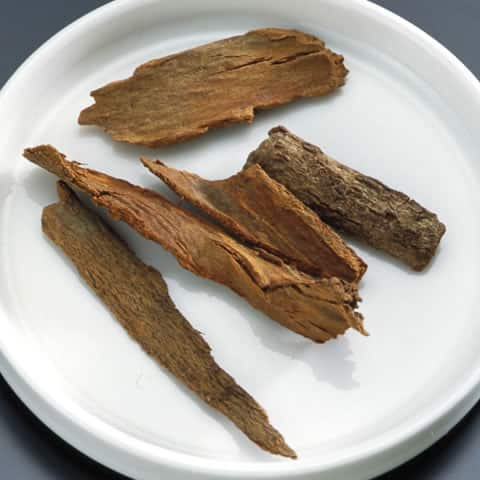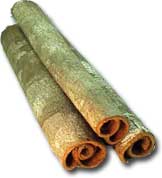けい‐ひ【×桂皮】
桂皮(ケイヒ)
ニッケイ属
(桂皮 から転送)
出典: フリー百科事典『ウィキペディア(Wikipedia)』 (2025/09/22 04:16 UTC 版)
| ニッケイ属 | ||||||||||||||||||
|---|---|---|---|---|---|---|---|---|---|---|---|---|---|---|---|---|---|---|
 
1. (上) セイロンニッケイの枝葉、
(下) インドグスの花 |
||||||||||||||||||
| 分類 | ||||||||||||||||||
|
||||||||||||||||||
| 学名 | ||||||||||||||||||
| Cinnamomum Schaeff. (1760), nom. cons.[3] |
||||||||||||||||||
| タイプ種 | ||||||||||||||||||
| セイロンニッケイ Cinnamomum zeylanicum Blume (1826) = Cinnamomum verum J. Presl (1823)[4][5] | ||||||||||||||||||
| シノニム | ||||||||||||||||||
| 和名 | ||||||||||||||||||
| ニッケイ シナモン |
||||||||||||||||||
| 英名 | ||||||||||||||||||
| Cinnamon | ||||||||||||||||||
| 下位分類 | ||||||||||||||||||
ニッケイ属(ニッケイぞく、学名: Cinnamomum)は、クスノキ科に分類される常緑木本の属の1つである。和名としてクスノキ属が充てられることもあるが[6][7][8]、2022年以降、クスノキなど一部の種はセイロンニッケイなどとは系統的にやや異なることが示され、別属 Camphora に分類することが一般的となっている。葉はふつう対生状、革質で3本の葉脈が目立つ(三行脈)(図1上)。花は6枚の花被片、9個の雄しべ、3個の仮雄しべ、1個の雌しべをもち(図1下)、果実は液果で黒紫色に熟する。南アジアから東アジア、東南アジア、オーストラリアの熱帯から温帯域に分布し、230種ほどが知られる。日本にはニッケイ、ヤブニッケイ、マルバニッケイなどが自生する。芳香性の精油を多く含み、セイロンニッケイ(狭義のシナモン)、シナニッケイ(肉桂、カシア)などは香料や香辛料、生薬として広く利用されている。学名の Cinnamomum はシナモンを意味し、ギリシア語の kinnamōmon(cinein = 巻く、amomos = 申し分ない)に由来する[6][9]。
特徴
常緑性の高木から低木[3][10][11](図2a)。精油を含み、樹皮や枝、葉にはしばしば強い芳香がある[3][10]。葉は対生またはややずれている[3][10][9][11](図2b)。葉身は革質、ふつう三行脈をもち、ドマティア(ダニ室)を欠く[10][11]。葉の表側(向軸側)表皮細胞は不定形で細胞壁が波状、表面が網目状[11]。
集散花序を形成し、腋生または頂生する[3][10](図2b)。花は小型から中型、ふつう両性、放射相称、3輪性、黄色から白色、花托は杯状から鐘状で短い[3][10][11](図2b, 3a)。花被片は6枚、3枚ずつ2輪、ふつう一部または全体が早落性[10][3](図3a)。雄しべはふつう9個、3個ずつ3輪、葯はふつう4室、外側2輪の雄しべは腺体を欠き葯は内向、第3輪の雄しべ基部には1対の腺体があり葯は外向[3][10][11](図2b, 3a)。仮雄しべは雄しべの内側に1輪3個あり、柄があり心形またはやじり形[3][10][11](図2b)。雌しべは1個、花柱は細く、子房と同長、柱頭は頭状、盤状または3裂[3][10](図2b)。果実は液果、成熟すると黒紫色を帯び、杯状や鐘形の果托に基部が覆われる[3][10][11](図2b, 3b)。
分布
インド、ヒマラヤ、中国、朝鮮半島、日本、台湾、フィリピン、インドシナ半島、マレー半島、インドネシア、ニューギニア島、オーストラリア東部に分布する[3]。
人間との関わり
ニッケイ属の植物はしばしば精油を多く含み、樹皮や葉、根皮、果実などが香料、香辛料、生薬などとして利用される[9](図4)。樹皮における精油の主成分はシンナムアルデヒドであることが多い[9]。ニッケイ属の植物またはその樹皮はシナモンや肉桂とよばれるが、狭義には、シナモンはセイロンニッケイ(Cinnamomum verum)、肉桂はシナニッケイ(Cinnamomum cassia または Cinnamomum aromaticum)を指す[9]。また、インドグス(Cinnamomum burmannii)、Cinnamomum loureiroi、タマラニッケイ(Cinnamomum tamala)も商業的に利用されている[12]。そのほかにも、いくつかの種が小規模に利用されている[9][12]。日本では、20世紀中頃までニッケイ[注 1](Cinnamomum sieboldii)の根皮が利用されていたが、現在ではほとんど利用されていない[9]。また、ニッケイ属の中には、木材用や観賞用として利用されるものもある[9][14]。
ニッケイ属の樹皮を乾燥させたものはシナモンとよばれ、狭義にはセイロンニッケイのものを指すが、シナニッケイなど他種のものもシナモンとされ、香料や香辛料として菓子や料理、飲料に広く利用されている[9][15]。セイロンニッケイのものに比べてシナニッケイに由来するものは香りと辛味が強く、甘味が少ないとされる[9][15]。
シナニッケイなどの樹皮を乾燥させたものは生薬とされ、桂皮(けいひ)ともよばれる[16][17]。また、細枝を乾燥したものは桂枝ともよばれる[17]。これらは芳香性健胃剤とされ、また漢方では発汗・解熱・鎮痛薬として用いられる[16][17]。
一方で、ニッケイ属植物は、肝毒性や発癌性を示すクマリンを含み、特にシナニッケイでは多いとされる[9][18]。
ニッケイ属植物の利用の歴史は古く、古代エジプトにおいてミイラの保存にセイロンニッケイやシナニッケイが使われていたとされる[9]。またヨーロッパや中国では、紀元前からニッケイ属植物の薬用利用についての記述がある[9]。日本では、正倉院に「桂心」の名で収納されている[9]。江戸時代には南西諸島原産のニッケイが本土南部で栽培されるようになり、その根皮が生薬や香料(八ツ橋、肉桂餅、ニッキ餅、ニッキ水など)に使われていたが、第二次世界大戦後はほとんど生産されていない[9][19]。
生薬
| 臨床データ | |
|---|---|
| その他名称 | 桂枝/桂皮 |
| 投与経路 | 経口(粉末、湯液) |
| 法的地位 |
|
| 識別子 | |
| KEGG | |
| 化学的および物理的データ | |
- 主な成分(KEGG C番号)
- シンナムアルデヒド(Cinnamaldehyde) — KEGG: C00903
- オイゲノール(Eugenol) — KEGG: C10453
- クマリン(Coumarin) — KEGG: C05851
分類
| 属/節 | Cinnamomum | Camphora |
|---|---|---|
| 葉序 | ほぼ対生 | 互生 |
| 葉脈 | 基本的に掌状脈 ダニ室なし |
基本的に羽状脈 ダニ室あり |
| 葉の向軸側表皮細胞 | 不規則 細胞壁は湾曲・網状 |
ほぼ同形 細胞壁はまっすぐ・平滑 |
ニッケイ属は大きな属であり、かつては新世界に分布するものを含めて350種ほどが分類されていた[11]。しかし系統分類学的な研究に基づき、新世界に分布するものは Aiouea 属に分けられた[11]。この時点でニッケイ属に残された種(アジアからオーストラリアに分布)は、形態的な特徴から2つの節(Cinnamomum sect. Cinnamomum、Cinnamomum sect. Camphora)に分類されることが多かった[11](表1)。その後、分子系統学的研究から、この2節が近縁ではないことが示され、Camphora節の種(クスノキなど約20種)は別属 Camphora に分類することが提唱されている[11]。その結果、2024年時点でニッケイ属(Cinnamomum)には230種ほどが残されている[3]。経済的に利用される種や和名をもつ種を以下の表2に示す。
表2. ニッケイ属のおもな種
- ニッケイ属 Cinnamomum Schaeff. (1760), nom. cons.[3]
- カナンニッケイ[20] Cinnamomum austrosinense Hung T.Chang (1959)[21]
- ベトナムニッケイ[9] Cinnamomum bejolghota (Buch.-Ham.) Sweet (1826)[22]
- インドグス[23] Cinnamomum burmannii (Nees & T.Nees) Blume (1826)[24]
- シナニッケイ(カシアニッケイ、トンキンニッケイ) Cinnamomum cassia (L.) D.Don (1825)[9][25]
- Cinnamomum chekiangense Nakai (1939)[28]
- マルバニッケイ[29] Cinnamomum daphnoides Siebold & Zucc. (1846)[30]
- シバニッケイ[31] Cinnamomum doederleinii Engl. (1884)[32]
- Cinnamomum dubium Nees (1831)[33]
- Cinnamomum heyneanum Nees (1831)[34]
- タイワンヤブニッケイ[35] Cinnamomum insularimontanum Hayata (1913)[36]
- ジャワニッケイ[37] Cinnamomum javanicum Blume (1826)[38]
- コウトウニッケイ[39] Cinnamomum kotoense Kaneh. & Sasaki (1826)[40]
- 台湾特産[40]。
- タイナンニッケイ[41] Cinnamomum macrostemon Hayata (1913)[42]
- Cinnamomum loureiroi Nees (1836)[43]
- ニッケイモドキ[44] Cinnamomum osmophloeum Kaneh. (1917)[45]
- ガジスグス[9] Cinnamomum parthenoxylon (Jack) Nees (1831)[47]
- オガサワラヤブニッケイ[48] Cinnamomum pseudopedunculatum Hayata (1913)[49]
- ハマグス[50] Cinnamomum reticulatum Hayata (1911)[51]
- 台湾に分布する[51]。
- コバノクスノキ[52] Cinnamomum rigidissimum H.T.Chang (1959)[53]
- 台湾、中国南部、ベトナムに分布する[53]。
- ニッケイ[54] Cinnamomum sieboldii Meisn. (1864)[55]
- ナガミグス[58] Cinnamomum subavenium Miq. (1858)[59]
- タマラニッケイ[60] Cinnamomum tamala (Buch.-Ham.) T.Nees & C.H.Eberm. (1831)[61]
- セイロンニッケイ[62] Cinnamomum verum (Buch.-Ham.) T.Nees & J.Presl. (1823)[5]
- ヤブニッケイ[63] Cinnamomum yabunikkei H.Ohba (2006)[64]
- Cinnamomum japonicum の学名が充てられたことがある[7]。Cinnamomum chekiangense に含められることもある[64]。日本(本州から南西諸島)、韓国南部諸島、台湾に分布する[8]。
- Cinnamomum wilsonii Gamble (1914)[65]
脚注
注釈
出典
- ^ 髙橋由紀子, 白水貴, 福田健二 & 山東智紀 (2015). “タイで発生したニッケイ属植物の奇形症状”. 樹木医学研究 19 (2): 104-105. doi:10.18938/treeforesthealth.19.2_104.
- ^ 御影雅幸 & 妹尾昌幸 (2003). “Cinnamomum tamala と C. impressinervium (クスノキ科) の葉の組織形態ならびにネパール産生薬 “Tejpat” の原植物”. 植物研究雑誌 (6): 330-335.
- ^ a b c d e f g h i j k l m n o p q r “Cinnamomum”. Plants of the World Online. Kew Botanical Garden. 2025年2月15日閲覧。
- ^ “Cinnamomum Schaeff.”. Tropicos v3.4.2. Missouri Botanical Garden. 2025年2月15日閲覧。
- ^ a b c “Cinnamomum verum”. Plants of the World Online. Kew Botanical Garden. 2025年3月22日閲覧。
- ^ a b 辻井達一『日本の樹木』中央公論社〈中公新書〉、1995年4月25日。ISBN 4-12-101238-0。
- ^ a b c 太田和夫 (2000). “クスノキ属”. 樹に咲く花 離弁花1. 山と渓谷社. pp. 394–405. ISBN 4-635-07003-4
- ^ a b c d e f g h i 米倉浩司 (2015). “クスノキ属”. In 大橋広好, 門田裕一, 邑田仁, 米倉浩司, 木原浩 (編). 改訂新版 日本の野生植物 1. 平凡社. pp. 79–81. ISBN 978-4582535310
- ^ a b c d e f g h i j k l m n o p q r s t u v w x y z aa ab ac ad ae af ag ah ai aj ak al am an ao ap aq ar as at au av aw ax 木村正典 (2024年2月3日). “シナモンの植物学と栽培”. 日本メディカルハーブ協会. 2025年3月22日閲覧。
- ^ a b c d e f g h i j k Flora of China Editorial Committee. “Cinnamomum”. Flora of China. Missouri Botanical Garden and Harvard University Herbaria. 2025年2月15日閲覧。
- ^ a b c d e f g h i j k l m Yang, Z., Liu, B., Yang, Y. & Ferguson, D. K. (2022). “Phylogeny and taxonomy of Cinnamomum (Lauraceae).”. Ecology and Evolution 12 (10): e9378. doi:10.1002/ece3.9378.
- ^ a b Suriyagoda, L., Mohotti, A. J., Vidanarachchi, J. K., Kodithuwakku, S. P., Chathurika, M., Bandaranayake, P. C., ... & Beneragama, C. K. (2021). ““Ceylon cinnamon”: Much more than just a spice”. Plants, People, Planet 3 (4): 319-336. doi:10.1002/ppp3.10192.
- ^ Flora of China Editorial Committee. “Cinnamomum cassia”. Flora of China. Missouri Botanical Garden and Harvard University Herbaria. 2025年2月11日閲覧。
- ^ 北村四郎・村田源 (1979). “ニッケイ”. 原色日本植物図鑑 木本編 2. 保育社. pp. 201–203. ISBN 978-4-586-30050-1
- ^ a b 「シナモン」『日本大百科全書(ニッポニカ)』。コトバンクより2025年3月22日閲覧。
- ^ a b 「桂皮」『デジタル大辞泉』。コトバンクより2025年3月22日閲覧。
- ^ a b c 「桂皮」『百科事典マイペディア』。コトバンクより2025年3月22日閲覧。
- ^ 「クマリン」『日本大百科全書(ニッポニカ)』。コトバンクより2025年3月15日閲覧。
- ^ 柳澤雅之 (2020). “アジアの薬用植物資源の生産・流通・利用の歴史に関する学際的研究 -シナモンがつなぐベトナムと日本- 第2章: 江戸時代のシナモンの受容と伝播 -諸国産物帳の分析から-”. CIRAS discussion paper 97: 17-27.
- ^ 米倉浩司・梶田忠 (2003-). “カナンニッケイ”. BG Plants 和名−学名インデックス(YList). 2025年3月22日閲覧。
- ^ a b “Cinnamomum austrosinense”. Plants of the World Online. Kew Botanical Garden. 2025年3月15日閲覧。
- ^ a b “Cinnamomum bejolghota”. Plants of the World Online. Kew Botanical Garden. 2025年3月15日閲覧。
- ^ 米倉浩司・梶田忠 (2003-). “インドグス”. BG Plants 和名−学名インデックス(YList). 2025年3月22日閲覧。
- ^ a b “Cinnamomum burmanniii”. Plants of the World Online. Kew Botanical Garden. 2025年3月15日閲覧。
- ^ 米倉浩司・梶田忠 (2003-). “カシアニッケイ”. BG Plants 和名−学名インデックス(YList). 2025年3月26日閲覧。
- ^ a b “Cinnamomum aromaticum”. Plants of the World Online. Kew Botanical Garden. 2025年3月26日閲覧。
- ^ EFSA Panel on Additives and Products or Substances used in Animal Feed (FEEDAP), Bampidis, V., Azimonti, G., Bastos, M. D. L., Christensen, H., Fašmon Durjava, M., ... & Dusemund, B. (2022). “Safety and efficacy of a feed additive consisting of an essential oil from Cinnamomum cassia (L.) J. Presl (cassia leaf oil) for use in all animal species (FEFANA asbl)”. EFSA Journal 20 (10): e07600. doi:10.2903/j.efsa.2022.7600.
- ^ a b “Cinnamomum chekiangense”. Plants of the World Online. Kew Botanical Garden. 2025年3月19日閲覧。
- ^ 米倉浩司・梶田忠 (2003-). “マルバニッケイ”. BG Plants 和名−学名インデックス(YList). 2025年3月22日閲覧。
- ^ “Cinnamomum daphnoides”. Plants of the World Online. Kew Botanical Garden. 2025年3月19日閲覧。
- ^ 米倉浩司・梶田忠 (2003-). “シバニッケイ”. BG Plants 和名−学名インデックス(YList). 2025年3月22日閲覧。
- ^ a b “Cinnamomum doederleinii”. Plants of the World Online. Kew Botanical Garden. 2025年3月19日閲覧。
- ^ a b “Cinnamomum dubium”. Plants of the World Online. Kew Botanical Garden. 2025年3月22日閲覧。
- ^ a b “Cinnamomum heyneanum”. Plants of the World Online. Kew Botanical Garden. 2025年3月22日閲覧。
- ^ a b 米倉浩司・梶田忠 (2003-). “タイワンヤブニッケイ”. BG Plants 和名−学名インデックス(YList). 2025年3月22日閲覧。
- ^ “Cinnamomum insularimontanum”. Plants of the World Online. Kew Botanical Garden. 2025年3月22日閲覧。
- ^ 米倉浩司・梶田忠 (2003-). “ジャワニッケイ”. BG Plants 和名−学名インデックス(YList). 2025年3月22日閲覧。
- ^ a b “Cinnamomum javanicum”. Plants of the World Online. Kew Botanical Garden. 2025年3月22日閲覧。
- ^ 米倉浩司・梶田忠 (2003-). “コウトウニッケイ”. BG Plants 和名−学名インデックス(YList). 2025年3月22日閲覧。
- ^ a b “Cinnamomum kotoense”. Plants of the World Online. Kew Botanical Garden. 2025年3月22日閲覧。
- ^ 米倉浩司・梶田忠 (2003-). “タイナンニッケイ”. BG Plants 和名−学名インデックス(YList). 2025年3月22日閲覧。
- ^ a b “Cinnamomum macrostemon”. Plants of the World Online. Kew Botanical Garden. 2025年3月22日閲覧。
- ^ a b “Cinnamomum loureiroi”. Plants of the World Online. Kew Botanical Garden. 2025年3月22日閲覧。
- ^ 米倉浩司・梶田忠 (2003-). “ニッケイモドキ”. BG Plants 和名−学名インデックス(YList). 2025年3月22日閲覧。
- ^ a b “Cinnamomum osmophloeum”. Plants of the World Online. Kew Botanical Garden. 2025年3月22日閲覧。
- ^ 「五加皮酒」『飲み物がわかる辞典』。コトバンクより2025-04-閲覧 エラー: 閲覧日が正しく記入されていません。(説明)。
- ^ a b “Cinnamomum parthenoxylon”. Plants of the World Online. Kew Botanical Garden. 2025年3月22日閲覧。
- ^ 米倉浩司・梶田忠 (2003-). “オガサワラヤブニッケイ”. BG Plants 和名−学名インデックス(YList). 2025年3月22日閲覧。
- ^ “Cinnamomum pseudopedunculatum”. Plants of the World Online. Kew Botanical Garden. 2025年3月22日閲覧。
- ^ 米倉浩司・梶田忠 (2003-). “ハマグス”. BG Plants 和名−学名インデックス(YList). 2025年3月22日閲覧。
- ^ a b “Cinnamomum reticulatum”. Plants of the World Online. Kew Botanical Garden. 2025年3月22日閲覧。
- ^ 米倉浩司・梶田忠 (2003-). “コバノクスノキ”. BG Plants 和名−学名インデックス(YList). 2025年3月22日閲覧。
- ^ a b “Cinnamomum rigidissimum”. Plants of the World Online. Kew Botanical Garden. 2025年3月22日閲覧。
- ^ 米倉浩司・梶田忠 (2003-). “ニッケイ”. BG Plants 和名−学名インデックス(YList). 2025年3月22日閲覧。
- ^ “Cinnamomum rigidissimum”. Plants of the World Online. Kew Botanical Garden. 2025年3月22日閲覧。
- ^ 牧野富太郎 (1989). “ニッケイ”. In 小野幹雄・大場秀章・西田誠. 牧野新日本植物図鑑. 北隆館. p. 121. ISBN 978-4832600102
- ^ 「島袋敬一編著 『琉球列島維管束植物集覧』 九州大学出版会、1997年。」より
- ^ 米倉浩司・梶田忠 (2003-). “ナガミグス”. BG Plants 和名−学名インデックス(YList). 2025年3月22日閲覧。
- ^ a b “Cinnamomum subavenium”. Plants of the World Online. Kew Botanical Garden. 2025年3月22日閲覧。
- ^ 米倉浩司・梶田忠 (2003-). “タマラニッケイ”. BG Plants 和名−学名インデックス(YList). 2025年3月22日閲覧。
- ^ a b “Cinnamomum tamala”. Plants of the World Online. Kew Botanical Garden. 2025年3月22日閲覧。
- ^ 米倉浩司・梶田忠 (2003-). “セイロンニッケイ”. BG Plants 和名−学名インデックス(YList). 2025年3月22日閲覧。
- ^ 米倉浩司・梶田忠 (2003-). “ヤブニッケイ”. BG Plants 和名−学名インデックス(YList). 2025年3月22日閲覧。
- ^ a b “Cinnamomum yabunikkei”. Plants of the World Online. Kew Botanical Garden. 2025年3月19日閲覧。
- ^ a b “Cinnamomum wilsonii”. Plants of the World Online. Kew Botanical Garden. 2025年3月19日閲覧。
外部リンク
- “Cinnamomum”. Plants of the World Online. Kew Botanical Garden. 2025年3月22日閲覧。(英語)
- “シナモン/Cinnamon”. エスビー食品. 2025年3月22日閲覧。
- “ケイヒ”. 生薬について. 養命酒製造株式会社. 2025年3月22日閲覧。
- “ケイヒ (桂皮)”. 生薬一覧. 日本漢方生薬製剤協会. 2025年3月22日閲覧。
- “ケイヒ末”. 薬の成分ディクショナリー. エスエス製薬. 2025年3月22日閲覧。
「桂皮」の例文・使い方・用例・文例
- >> 「桂皮」を含む用語の索引
- 桂皮のページへのリンク














